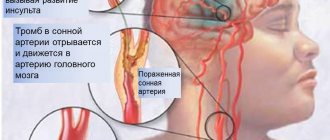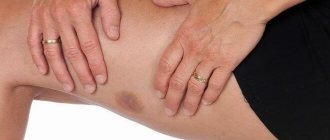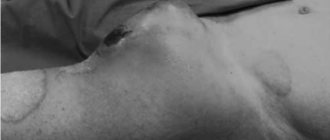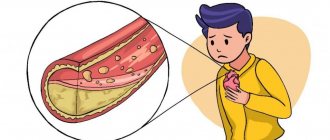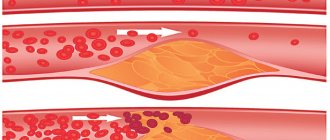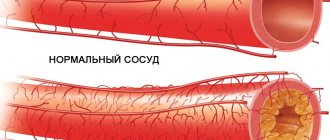Hormones, fat and genes
Yulia Borta, AiF: Konstantin Borisovich, what are atherosclerotic plaques in blood vessels? And why do they suddenly appear?
Konstantin Frolov : Atherosclerotic plaques are deposits of lipids, that is, fats. There are many theories about the development of atherosclerosis, but why this begins to happen is not completely clear. It has been established that heredity plays a major role in the development of the disease. As a rule, in patients who suffer from atherosclerosis, relatives were ill or died from its complications: stroke, heart attack, etc. No one disputes an excess of animal fats in food as the main provoking factor in the development of atherosclerotic plaques. The negative effects of smoking have also been proven. Among our patients, more than 90% are experienced smokers.
Article on the topic
Don't be afraid of fat. How to eat to get rid of atherosclerosis? However, following a healthy diet does not provide a 100% guarantee that the disease will not appear. There are interesting studies that have shown that through various hormonal manipulations it is possible to induce the development of significant atherosclerosis in herbivores that have not eaten a single gram of animal fat in their lives. So there are many theories on this topic, but none of them gives a comprehensive answer to the question about the causes of atherosclerosis. Therefore, we can fight, alas, only with its consequences.
— With excess fat it’s understandable. How does calcium appear in plaques?
— With pathological changes in the vessel wall, when its nutrition is disrupted, first fibrosis occurs, the formation of connective tissue, and then calcification, that is, the deposition of calcium in this area. This is the final stage of plaque development, when it becomes hard and stable. Before this, the plaque has a softer structure; parts of it can come off, “fly away” with the bloodstream and clog smaller blood vessels.
"They won't go away"
— Is the process of atherosclerosis already begun irreversible?
“Unfortunately, the atherosclerotic plaques that have already formed will not “resolve.” And conversations about miracle drugs, IVs that dissolve plaques, have nothing to do with reality. We can only slow down the process of plaque increase in size and prevent complications of atherosclerosis that are dangerous to health and life.
Article on the topic
We ran away from a heart attack and caught up with him. How sports can lead to atherosclerosis
“Nevertheless, the Internet is full of advice on how to clean vessels.
— This formulation is incorrect and is used to promote artisanal treatment methods. There is no cleaning, only surgical techniques.
— For atherosclerosis, statins are usually prescribed. However, information has emerged that they can lead to the development of cancer.
— The effectiveness of statins in the treatment of atherosclerosis has been absolutely proven by multicenter studies. Their use can reduce the number of dangerous complications in patients suffering from atherosclerosis and lipid metabolism disorders, and slow down the further development of atherosclerotic plaques.
Yes, statins have side effects. The most well-known is liver dysfunction. Therefore, these drugs are used under laboratory monitoring of liver function. In case of obvious changes, the dosage is reduced or statins are discontinued.
Article on the topic
Statins and discipline. Reducing blood pressure in Russian
— Tell us about surgical methods for treating atherosclerosis.
— Today, three main methods are used.
Open vascular surgery:
— The artery is opened, the plaque is removed, and the lumen of the vessel is sutured (so-called endarterectomy).
— Bypass surgery. In case of longer vessel blockage (10-15 cm or more), shunts are used. A backup artificial vessel made of synthetic materials or autovenous is sewn to the artery to ensure blood flow bypassing the area of narrowing or blockage.
Endovascular (intravascular) techniques are considered the most progressive today and are increasingly used in the world. In this case, the blockage or narrowing of the vessel is eliminated without cutting the skin, through a puncture in the artery. For example, we can make a puncture in the leg or arm and pass instruments through the lumen of the vessel into the femoral, carotid, and coronary arteries. The access zone and the operation zone are often tens of centimeters apart. In the place of the blocked plaque, we restore the lumen, insert a balloon, push apart the walls of the vessel and install a frame (stent) that will support the created lumen.
— Do such operations cure forever?
“Unfortunately, eliminating the narrowing and restoring blood flow in one place does not stop the development of the process in other vessels. Especially if a person does not change his lifestyle: he continues to eat poorly, moves little, smokes. There are patients whom I operated on the arteries of the legs, brain, and aorta. Although all patients are given recommendations upon discharge after vascular surgery, on nutrition, observation by a cardiologist and surgeon, and ultrasound monitoring of the condition of blood vessels, few follow them. Most, when they are no longer bothered by previous complaints, return to their usual way of life. And then they come with a new problem.
Article on the topic
Neither sigh nor groan. Atherosclerosis of blood vessels threatens to turn into a heart attack
CHOLESTEROL PLAQUES: RISK FACTORS, TREATMENT, PREVENTION
Cholesterol plaques are formations on the walls of blood vessels that provoke the development of diseases of the cardiovascular system. Cholesterol plaques begin to form on the walls of the arteries and grow over many years, slowly blocking blood flow. Even worse, the plaque may suddenly rupture, causing a blood clot (thrombus) to form over the rupture site, which can lead to a stroke or myocardial infarction. Blocked arteries caused by the growth of cholesterol plaques and blood clots are the leading cause of death in developed countries. Lowering your cholesterol levels and eliminating other risk factors can help prevent the growth of cholesterol plaques. In some cases, it is even possible to achieve a reduction in these formations, which in turn helps to get rid of vascular and heart diseases.
Cholesterol plaques and atherosclerosis
The process of formation of cholesterol plaques, in which not only the formation of these fatty deposits occurs, but also the hardening of the arteries is called atherosclerosis. LDL or “bad cholesterol” is the building block of cholesterol plaques. Vascular atherosclerosis develops slowly and asymptomatically, often beginning in childhood (usually at the age of 10-12 years). Eventually, the arteries can become so blocked that blood flow can be cut off altogether. Atherosclerosis of blood vessels often causes heart attacks, strokes and peripheral artery disease. All these conditions can be classified as cardiovascular diseases. Cardiovascular disease is the No. 1 killer in developed countries, causing more than 900,000 deaths annually in America alone.
What are cholesterol plaques?
Cholesterol plaques begin to form on the walls of the arteries. Long before they can be called plaques, they appear as fatty streaks in large arteries, even in some teenagers. It is these bands that are the precursors of cholesterol plaques. They cannot be detected through diagnostic procedures, but researchers have discovered them during autopsies of young victims of accidents and violence. Atherosclerosis develops over many years. During this period, a complex process of formation of cholesterol plaques occurs, which includes:
Damage to arterial endothelium . The smooth, delicate lining of blood vessels is called endothelium. High cholesterol, smoking, high blood pressure (hypertension) or diabetes can damage the endothelium, creating space for cholesterol to leak into the artery wall.
Cholesterol invasion . “Bad cholesterol” (LDL), circulating in the blood, penetrates the damaged endothelium, after which it begins to accumulate in the artery wall.
Plaque formation . Macrophages (scavenger cells), which process various harmful substances, bacteria and cholesterol, also fill cholesterol plaques, and over many years the toxic mass of cholesterol and these cells forms a dense plaque on the artery wall.
Why are cholesterol plaques dangerous?
Once cholesterol plaques form on artery walls, they can behave in a variety of ways.
They can grow into the artery wall . Cholesterol plaques may stop growing or may grow into the inner wall of a blood vessel without impeding blood flow.
Plaques can slowly grow, increasingly blocking blood flow . Slow-growing cholesterol plaques may or may not cause any symptoms—even when the arteries are severely blocked.
Cholesterol plaques can suddenly rupture—worst-case scenario . This provokes blood clotting and blood clot formation, which can lead to myocardial infarction or stroke.
The formation of cholesterol plaques causes the development of three main types of cardiovascular diseases:
Cardiac ischemia . The presence of plaque in the arteries of the heart may not cause any symptoms or may lead to chest pain, a condition called angina. The sudden rupture of a cholesterol plaque and the formation of a blood clot in an artery can block this blood vessel, leading to the death of the heart muscle (myocardial infarction).
Cerebrovascular disease . Cholesterol plaques can rupture in one of the brain's arteries, causing a stroke and leading to permanent brain damage. Blocked blood vessels can also cause transient ischemic attacks (TIAs). A TIA causes symptoms similar to those of a stroke, but they are temporary and do not damage the brain as much. However, patients experiencing a TIA are at very high risk of developing a stroke, and it is important to begin appropriate treatment as quickly as possible and take all necessary precautions.
Peripheral arterial diseases . Blocked arteries in the legs can lead to pain when walking and poor wound healing due to poor circulation. A severe stage of the disease can lead to amputation of limbs.
Prevention
Over time, atherosclerosis progresses and cholesterol plaques increasingly narrow the ducts of important blood vessels. How to prevent the development of this insidious disease? There are nine risk factors that are responsible for up to 90% of all heart attacks. These risk factors include:
smoking
high cholesterol
high blood pressure
diabetes
abdominal obesity
stress (see How to get rid of stress )
insufficient consumption of fruits and vegetables
excessive alcohol consumption
sedentary lifestyle
You may notice that almost all of them are quite common. Experts agree that reducing and completely eliminating risk factors leads to a reduced risk of developing cardiovascular disease. For people with moderate or end-stage atherosclerosis, daily baby aspirin may be indicated to help prevent blood clots. Before you start taking baby aspirin, check with your doctor because... this drug may cause various side effects.
How to get rid of cholesterol plaques?
If cholesterol plaques have already formed, then, as a rule, this is forever. Although with effective treatment their growth can be slowed down or even stopped. Some evidence suggests that with persistent treatment, cholesterol plaques may even shrink slightly in size. The results of one significant study showed that after reducing blood cholesterol levels by 50%, cholesterol plaques decreased in size by 10%. The best way to treat cholesterol plaques is to prevent their formation or progression of the disease. This can be achieved through lifestyle changes and, if necessary, appropriate treatment.
Medications and lifestyle changes to reduce the risk of atherosclerosis
Reducing and eliminating risk factors leading to the development of atherosclerosis helps to slow down or stop the development of cholesterol plaques. Ways to reduce the amount of cholesterol in the body are:
taking medications that lower “bad cholesterol” levels
taking medications to reduce high blood pressure
use of folk remedies healthy diet
regular physical activity
to give up smoking
These methods won't help clear your arteries of cholesterol plaque, but they can go some way to reducing your risk of heart attacks and strokes. There are various medications that can help you lower your blood cholesterol levels. Among them:
statins
fibrates
niacin
bile acid sequestrants
Procedures to improve blood flow
Using invasive procedures allows doctors to see the condition of the arteries and improve blood flow or restore it by using other vessels to bypass the blocked artery. These procedures include:
Angiography, angioplasty and stenting . Using a catheter inserted into an artery in the leg and X-rays, doctors can examine diseased arteries. This procedure is called cardiac catheterization. A tiny air balloon is inflated in the area where cholesterol plaque has severely narrowed the lumen of the vessel, after which a metal stent is implanted there, which will subsequently help keep the blocked arteries open.
Bypass surgery . Surgeons take a healthy vessel from the leg or chest and use it to bypass the area of the blocked artery, thereby restoring blood circulation.
These procedures cannot be called absolutely safe, because... they carry a certain risk of complications. A patient may be referred for one of these procedures only if he has severe symptoms associated with the presence of cholesterol plaques and cardiovascular diseases associated with atherosclerosis.
Head of the therapeutic department Safonov A.A.

